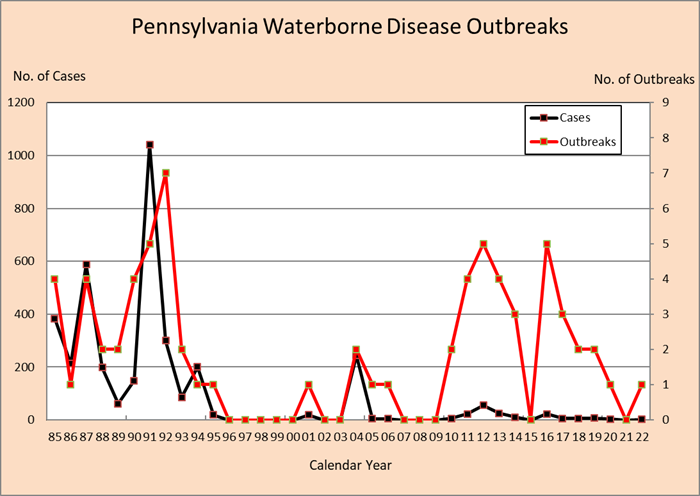Waterborne Diseases in Pennsylvania
The Waterborne Disease and Outbreak Surveillance System (WBDOSS) is the primary source of data concerning the scope and health effects of waterborne disease outbreaks in the United States. CDC and the U.S. Environmental Protection Agency (EPA) periodically review outbreak reports from U.S. states and jurisdictions and report on outbreak characteristics, including the water systems, venues, settings, numbers, and causes of outbreak-related illnesses.
CDC published summary reports in MMWR Surveillance Summaries for outbreaks reported from 1971–2008. Outbreak report data from 2009 forward are published in the MMWR Weekly with supplemental content posted on their website.
To read the summaries, visit CDC's
Waterborne Disease & Outbreak Surveillance Reports webpage.
The CDC defines an outbreak as involving at least two persons experiencing a similar illness after consuming drinking water, along with evidence that water is the most likely source of the illness. In addition, an investigation of the exposed population must point to drinking water as the probable source of the illness.
In the Twentieth Century, waterborne diseases associated with drinking water were common, often leading to hundreds of deaths in the nation. Even in later years-from 1971 to 1985-Pennsylvania reported more waterborne disease outbreaks associated with drinking water than any other state. Although these diseases were not as severe, even outbreaks of mild diarrheal illness can lead to time off from work, school, or recreation, resulting in significant economic consequences.
Dramatic improvements in the state's drinking water systems during the 1990's have led to sharp reductions in waterborne diseases. For example, following more stringent regulations, nearly 250 water systems in the commonwealth abandoned unfiltered surface water sources. Because these systems only used disinfection for treatment, consumers were more vulnerable to disease outbreaks when the disinfection facilities failed or when organisms resistant to disinfection were present in the water supply.
Other efforts have reduced the occurrence of outbreaks. The Department of Environmental Protection (DEP) and county health departments have improved inspections and design requirements since 1984, when the state acquired primacy for the safe drinking water program. DEP also works closely with surface water systems by using special programs like
Filter Plant Performance Evaluations, the
Partnership for Safe Water, and other training and outreach programs. Low-interest loans through the
PENNVEST initiative have enabled water suppliers to improve drinking water infrastructure.
With the help of local public health agencies, DEP and the Pennsylvania Department of Health are continuing to further improve the state's disease detection, investigation and reporting system. Currently, more than 10 million Pennsylvanians and numerous out-of-state visitors receive their drinking water from over 2,100 community water systems in the state.

For more information:
Contact: DEP-Safe Drinking Water Program
Phone Number (717) 787-9633